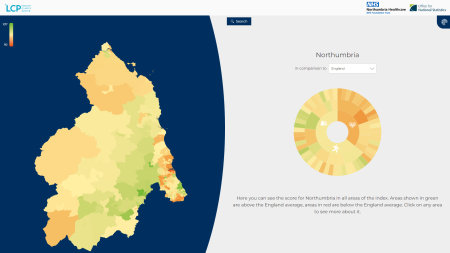Publish date: 8 November 2022
First local Health Index goes live today

A North East hospital trust is the first in the country to develop and pilot a local Health Index tool, which gives greater insight into population health at a much more local level.
Northumbria Healthcare NHS Foundation Trust has worked to produce the tool, which anyone will be able to access, with the Office of National Statistics (ONS), national public health expert and chair of the trust’s health inequalities programme board, Dr Jonathan Pearson-Stuttard, and two local authorities.
The ONS’s Health Index allows people to look at how health has improved or declined over time, how this varies by area and what is driving this.
Using the national Health Index framework and data from Northumbria Healthcare, Northumberland County Council, North Tyneside Council and other local NHS organisations, the local Health Index tool can provide population health information for each small neighbourhood – around 1,500 people.
The Index will crucially allow the trust, which provides hospital and community care to half-a-million people living in Northumberland and North Tyneside, to help ensure the care they provide in local communities addresses the healthcare needs of the local population.
Northumbria Healthcare's chief executive, Sir James Mackey, said: “The development of the local Health Index is testament to the power of collaborative working. It also clearly demonstrates our trust’s commitment to tackle health inequalities, continually improve the services and care we provide to our patients and improve the health and wellbeing of the local communities we serve.
“Having the ability to understand in detail how and why health differs between different communities across our patch gives us very valuable and powerful insight allowing us to help improve peoples’ lives and target healthcare interventions where they are most needed.
“This information will allow health leaders, clinicians and other partners to have informed and real-time discussions about health. I would like to thank everyone involved in helping to develop the local Index and look forward to further developing its use.”
The Health Index is split into three categories – healthy people (health outcomes), healthy lives (health-related behaviours and personal circumstances) and healthy places (wider social, economic and environmental drivers of health).
These categories can then be broken down further into sub-categories to focus on health topics, such as mental health and economic and working conditions. The sub-categories consist of 56 specific indicators of health, including obesity, alcohol misuse and air pollution.
Each indicator has a national average score of 100. The scores of local indicators can then be compared with the national data to measure the health of local communities.
The local Health Index is available at https:/
Dr Pearson-Stuttard said: "Our prototype local Health Index makes clear the large variations in health and the drivers of health across the Northumbria population. Health Index scores range from 108 in Whitley Sands and Darras Hall to 92 in Blyth. The differences are even larger when looking at the domains of the Health Index - healthy people, healthy lives and healthy places - with a 24-point difference between the most and least healthy areas for health outcomes (the healthy people domain).
“Generating data about the health of our population at very small areas, that groups residents into 328 small areas of 1500 people, allows us to see the variation in health need, and the inequalities in the drivers of health, in much greater detail than before. While there are statistical challenges to overcome in future versions of the local Health Index, we hope that this could provide a framework for local health systems, including integrated health systems, for targeted action to address inequalities in health in a more effective and timely manner in the future.”
Emma Rourke, Interim Deputy National Statistician (Health, Population and Methods) at ONS, said: "The value of the Health Index is not only in the broad understanding it provides of our health as a country, but the local insights it provides. Our collaboration with Northumbria Healthcare NHS Foundation Trust shows the potential for the Heath Index to become a ‘small area’ health tool to guide planning for local population health improvements.
“This project shows the practical use of the Health Index framework which the innovative team at Northumbria has already used to help shape health priorities. ONS is currently working to update the Health Index to reflect 2021 data, which we aim to publish in the Spring. Alongside this, we will continue our work with Northumbria on this pioneering use of local health data in working towards healthier communities."
Professor Chris Whitty, chief medical officer for England, said: “Data that allow us to track progress in improving health at national, regional and local levels are very important in improving health. By gathering information on health challenges, we are better placed to respond to them. Then data allow us to see whether interventions have worked, and alter, end or extend them.
“We know there is a stark variation in health across the country when comparing different areas and more granular data will better equip health partners to work together to improve health for everybody, now and in the longer term.
“I strongly support efforts to provide more detail across a wide range of healthcare indicators.”
As demonstrated in its development, the tool will further encourage collaborative working between healthcare organisations and other agencies.
Directors of Public Health for North Tyneside and Northumberland, Wendy Burke and Liz Morgan, said: “We are determined to narrow the gap in inequalities across the borough and our county. We are working hard with our partners to tackle health and prosperity disparities, ensuing we break the link between people’s background and their prospects for a healthy, thriving and happy life.
“The health index tool will provide a more in depth understanding of how health differs across the area that Northumbria NHS Trust serves. With data available at a neighbourhood level, this means that we can target our partnership efforts to reduce inequalities across our respective council areas.”
Media contacts
Northumbria Healthcare NHS Foundation Trust - cara.
ONS – lorna.
